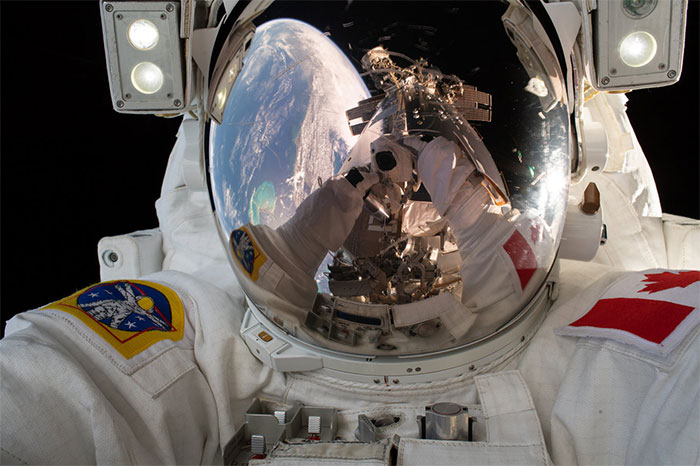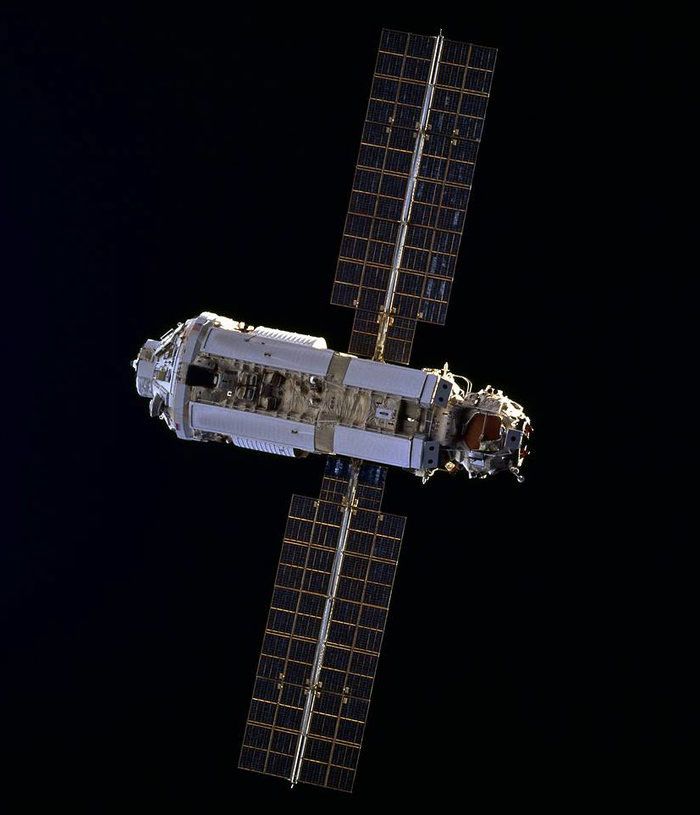The uncertain future of the ISS space station when NASA returns to the Moon
The International Space Station (International Space Station - ISS) is 18 years old, operating in a harsh space environment and spending billions of dollars each year to operate.
When the first modular carrier missile of the International Space Station (ISS) was launched in Kazakhstan in November 1998, NASA officials announced the station would serve as the astronauts' home on the fund. Earth religion for at least 15 years.

Image of the International Space Station reflected through the hat of engineer David Saint-Jacques, Canadian Space Agency.(Photo: NASA).
By this time, ISS has been operating for over 18 years and is still continuing to serve. This is an impressive space station on orbit, with a living space of a 6-bed house, 2 bathrooms and a large window overlooking the Earth.
The US, Russia and international partners have lost two decades and over $ 100 billion to bring the ISS station into operation. The problem now is that, while the US Aeronautics Agency (NASA) aims to bring people back to the Moon, this "old" orbit is becoming a financial burden and unknown. Where will its future go?

The first module of ISS, Zarya Control, was launched by Russian Proton missile from Baikonur Cosmodrome, Kazakhstan space airport, on November 20, 1998.
Every year NASA has to spend 3-4 billion dollars to operate orbit stations as well as bring astronauts back. This figure accounts for about half of the budget for NASA's space exploration activities.
The United States and other countries have pledged to contribute funds to maintain the ISS until at least 2024, but it will certainly last longer than that. Gilles Leckerc, director of space exploration at the Canadian Space Agency, said it would not be possible for international partners to sit together within the next five years and decide to let ISS crash into the sea, then transfer direct resources to other space goals.
'It will be a waste. We cannot throw away the ISS when we have invested too much in it. It is clear that the partners agree that we still need a space station in Earth's low-level orbit , NPR quoted Mr Leclerc as saying.

The ISS image was taken from the space shuttle Atlantis on May 23, 2010.(Photo: NASA).

Engineer delegation on flight number 59 includes (left) Anne McClain, David Saint-Jacques and Christina Koch in the laboratory on ISS.(Photo: NASA).
So NASA proposed a thrifty idea, which is to move the space station to private property. That's why several weeks ago, NASA officials held a press conference at the NASDAQ stock exchange in New York City.
'NASA is opening the International Space Station with commercial opportunities and promoting these opportunities, something we have never done before ,' NASA Chief Financial Officer Jeff DeWit told the event. 'The commercialization of Earth's low orbit will allow NASA to focus its resources on bringing the next and American woman back to the Moon by 2024 in the first phase to build a Sustainable presence in the Moon to prepare for future missions to Mars'.
Also at the conference, astronaut Christina Koch appeared in the video taken from the universe saying : 'We are happy to be part of NASA's program when our laboratory and home are in The universe is turned into a place for commercial and promotional opportunities as well as for private astronauts'.
With John Logsdon at the George Washington University, all these initiatives have been mentioned in the past, when ISS was not even born. Back in the 1980s, when President Ronald Reagan's government first proposed building a permanent space station, the plan included the idea that this place could "become a place serving a series of "Trading is different, earning billions of dollars ," Mr. Logsdon said. "We are in 2019 and will eventually test that hypothesis."

NASA engineer Anne McClain is working outside ISS in April 2019.(Photo: NASA).
However, when reporters asked about the amount of profits expected from new commercial activities on ISS, NASA officials did not give any figures saying that there are still many uncertainties."Markets and services, to generate revenue, will need to have private business and creative involvement , " NASA spokesman said.
"That's a good answer because they themselves don't know , " said Tommy Sanford, executive director of the Trade Flight Federation.
But if ISS becomes a commercial destination, even privately owned, then NASA could only be one of the station's many customers."You need to focus on adding as many customers as possible and hoping to reach the" breaking point ", when you can keep them all ," Mr. Sanford said. 'That will eventually reduce NASA's costs, because you are just one of many customers. NASA does not have to bear the entire cost of infrastructure and transportation anymore . '

Japanese astronaut Koichi Wakata works on ISS.(Photo: NASA).
However, another question is whether any enterprise is willing to adopt a space station without the government behind the "pumping" of money. 'To be honest, the meager commercial benefits that ISS has shown in nearly 20 years of operation have forced us to halt current NASA plans,' NASA Inspector Paul Martin told Parliament in the year. last.
While all discussions are ongoing, ISS is getting older every day. The universe is a harsh environment. Hardware devices are worn out and important components on the station are only certified until 2028.
"The space station is actually less than 10 years old," said Dava Newman, a scientist at MIT and a former deputy director of NASA. Ms. Dava has gone to ISS to do experiments and love this 'house' , but she thinks that while time is running fast, a strategic plan for the end of ISS is required.
'Some components of the space station should be delivered to the private sector, one or two modules, for example. All must be taken into account, perhaps with government budgets , "Dava said.

SpaceX Crew Dragon appeared on Earth's horizon in the first commercial flight to ISS called Demo-1.(Photo: NASA).
And finally, according to the rules, large parts of ISS will also have to fall back to Earth. When asked when NASA planned to divert the trajectory to see ISS "retire" , a spokesman for the agency said it had yet to set a specific year.
'The transformation of the space station will only happen when commercial destinations can be made available and can support NASA's needs as one of many customers,' NASA spokesman said. know.
- NASA built a space station in the middle of the moon
- NASA has just revealed an exciting plan from now until 2030
- The uncertain future of ISS
- ISS International Space Station is about to end its historic mission
- China successfully tested the Module for the future Moon Station
- NASA revealed the time of the first immigration settlement on the Moon
- NASA celebrates 40 years of the first space station project
- Russia announced the race to build the Moon space station
- ISS station flies over the Moon
- NASA announced it would soon leave the ISS, hoping to return to the Moon
- Russia - America cooperated to build a space station on the Moon
- Use a 3D printer to build a space station
 Van Allen's belt and evidence that the Apollo 11 mission to the Moon was myth
Van Allen's belt and evidence that the Apollo 11 mission to the Moon was myth The levels of civilization in the universe (Kardashev scale)
The levels of civilization in the universe (Kardashev scale) Today Mars, the sun and the Earth are aligned
Today Mars, the sun and the Earth are aligned The Amazon owner announced a secret plan to build a space base for thousands of people
The Amazon owner announced a secret plan to build a space base for thousands of people